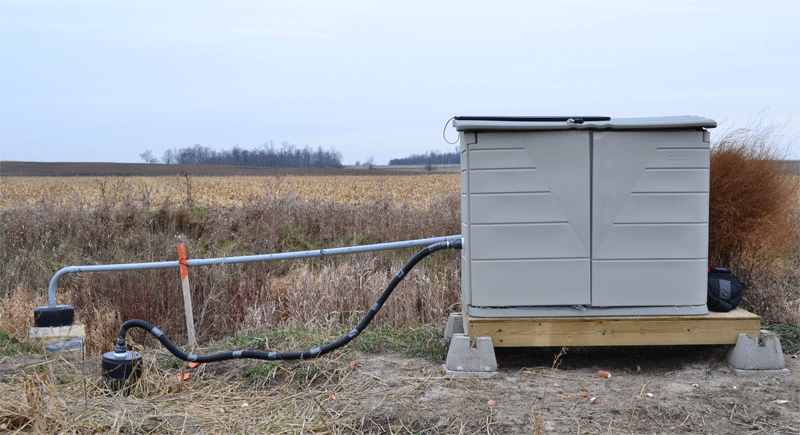Controlled drainage
MEASURING THE ECONOMIC AND ENVIRONMENTAL BENEFITS
THE INSTALLATION OF controlled drainage and the equipment to measure its effects is now complete at the farm of Henk and Annie Van Den Berg in Lucan, Ontario.
PHOTO: TILE RUNOFF WILL BE SAMPLED ANNUALly USING A HACH – AMERICAN SIGMA 24-BOTTLE AUTOSAMPLER. SAMPLES WILL BE TRIGGERED BASED ON A FLOW-BASED REGIME (outside view of the system).

Controlled drainage delivers benefits for farmers and the environment that standard drainage cannot offer. Each controlled drain, placed just before the outlet, consists of a plastic tube 45 centimetres wide and almost two metres long, integrated with the existing drainage tile. Inside each tube are vertical plastic panels that can be pulled up to let the water flow freely, or pushed downward to stop it.
The system is meant to be left open in the spring and fall to drain the field and closed during the summer to retain both nutrients and water. However, controlled drainage systems only work well on flat topography. With fields that are not flat, more controlled drain structures would be required to control water flow, with structures in the field itself instead of just at the outlet at the edge of the field. In-field instruments would interfere with equipment movement during planting, spraying, and harvesting.
ON-FARM STUDY
Two controlled drains, each covering a five-acre field, were installed at the Van Den Berg farm in spring 2014 by McCutcheon Farm Drainage of Thorndale. The study of these drains is being spearheaded by the Upper Thames River Conservation Authority (UTRCA) and Agriculture and Agri-Food Canada (AAFC).
“The overall goal is to address a number of adoption barriers that have been identified by both producers and tile drain contractors,” says AAFC senior water management engineer Andrew Jamieson. “There is a lot of science that has shown the benefits of controlled drainage from an environmental point of view (less run-off), but what we hope to accomplish with these projects is a better understanding of how controlled drainage works at a farm level and the challenges of managing such a system from a producer’s point of view.”
For example, producers need to be able to know when the water table should be raised, or how long in a wet year the field should be left to freely drain. It’s estimated that about 80 to 90 per cent of the phosphorous and nitrogen in a field will stay put with controlled drainage compared to what would have been lost into the watershed with conventional tile.
ECONOMICS
Jamieson says the project also aims to answer some of the economic questions surrounding controlled drainage.
“Research has shown that the yield bump from controlled drainage systems doesn’t happen every year [for example, in wet years], so we need a better grasp on how often a producer will see the yield bump and how a producer can manage the controlled drainage system to optimize yield,” he explains.
Brad Glasman, UTRCA conservation services co-ordinator, notes that over time, controlled drainage should increase yields by 10 to 15 per cent. The structures cost approximately $700 each plus installation. The point farmers could expect to break even on the investment depends on yearly crop yields and prices, weather patterns, snow melt, soil type, and other factors.
“Tile drainage contractors have also asked for guidelines and standards for the installation of controlled drainage systems, so we hope this work can lay the foundation for that,” Jamieson explains. “The contractor is the first point of contact for producers regarding drainage on their farm, and if we don’t resolve the contractors concerns with controlled drainage then the adoption of the system will remain slow.”
McCutcheon Farm Drainage owner Ken McCutcheon says that in addition to requiring flat topography, controlled drainage systems are much more effective with newer tile drainage systems. “With the more widely-spaced tile in older systems, you’re backing the water up and the water level will vary because of the distance,” he says. “In newer systems, more pipes in the ground means a more uniform water table can be achieved.”
ENVIRONMENTAL EFFECTS
Annual measurement of tile water flow at the Van Den Berg farm began in December 2014 through the use of two different methods (in case one fails, and also to get a sense of which method costs less). Measurement of the ability of controlled drains to achieve a constant water table depth will commence during the growing season in 2015. Water table depth and soil moisture values will be compared against crop yields.
The study of controlled drains has been going on for more than two decades at the AAFC research station in Harrow, and it has included an evaluation of the annual impact of controlled drainage on nutrient loading from tile and surface runoff on a plot scale. However, Jamieson notes that research in Canada has generally had an overall focus on its function and effects during the growing season. A look at the entire year is more valuable as it provides the entire picture, and that’s why Jamieson and his colleagues are taking on the challenge of monitoring over the winter months, attempting to study the annual impacts of controlled drainage on a field scale.
He notes that, “some recent research results out of Ohio where controlled drainage was used in fields after harvest until the spring time show a 40 to 70 per cent reduction in dissolved phosphorus loads. We are looking forward to seeing what conclusions we can draw from our year-round study.” •







